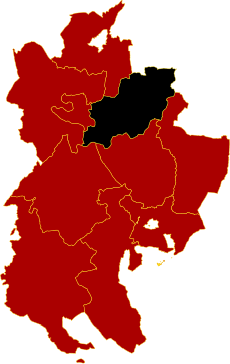Barford Hundred: Difference between revisions
No edit summary |
No edit summary |
||
| (One intermediate revision by one other user not shown) | |||
| Line 1: | Line 1: | ||
[[File:Bedfordshire | [[File:Barford Hundred - Bedfordshire.svg|thumb|230px|Barford Hundred shown in Bedfordshire]] | ||
The '''Hundred of Barford''' is a hundred in the north-east of [[Bedfordshire]], butted up against neighbouring [[Huntingdonshire]], from which it is separated by the [[Great Ouse]]. Five other Bedfordshire hundreds adjoin it | The '''Hundred of Barford''' is a hundred in the north-east of [[Bedfordshire]], butted up against neighbouring [[Huntingdonshire]], from which it is separated by the [[Great Ouse]]. Five other Bedfordshire hundreds adjoin it, namely, running clockwise from the south, [[Biggleswade Hundred|Biggleswade]], [[Wixamtree Hundred|Wixamtree]], [[Redbornestoke Hundred|Redbornestoke]], [[Willey Hundred|Willey]] and [[Stodden Hundred|Stodden]]. The ancient parishes of [[Bedford]] north of the Ouse, namely St Cuthbert, St Paul and St Peter, are geographically situate in this hundred, giving it a total population in 2011 of 79,330. | ||
The boundaries of this hundred have not altered since the [[Domesday Book]], in which for this hundred are listed 114 hides at [[Great Barford]], [[Colmworth]] with Channels End, [[Eaton Socon|Eaton]] with [[Wyboston]] and [[Sudbury Bedfordshire|Sudbury]], Goldington with Putnoe, Salph End (in Ronhale), [[Roxton]] with [[Chawston]] and [[Wilden, Bedfordshire|Wilden]]. Ravensden is not mentioned in the Survey at all. | The boundaries of this hundred have not altered since the [[Domesday Book]], in which for this hundred are listed 114 hides at [[Great Barford]], [[Colmworth]] with Channels End, [[Eaton Socon|Eaton]] with [[Wyboston]] and [[Sudbury Bedfordshire|Sudbury]], Goldington with Putnoe, Salph End (in Ronhale), [[Roxton]] with [[Chawston]] and [[Wilden, Bedfordshire|Wilden]]. Ravensden is not mentioned in the Survey at all. | ||
| Line 16: | Line 16: | ||
==History== | ==History== | ||
Barford has always been a royal hundred, though farmed out at various times In the Feudal Aid of 1302, knight service | Barford has always been a royal hundred, though farmed out at various times In the Feudal Aid of 1302, knight service was owed for eighteen fees in this hundred, and in 1346 nearly fifteen fees were assessed at £29 8s. 8d. On the occasion of a general muster in 1539, Barford provided 44 archers, 130 billmen and 20 pairs of harness. | ||
In 1629 Charles I made a grant of the hundred to Gilbert North at a yearly rent of £12 4s. 8½d. to be held as of the manor of East Greenwich in free and common socage. The ship-money levied on Bedfordshire in 1638 produced £4 13s. from Barford. A survey of the hundred made during the Commonwealth states that at that time the hundred had passed to Oliver Earl of Bolingbroke, who held it in common with Stodden Hundred. (fn. 10) Like that hundred it is declared by Lysons to have been the possession of Lord St John (the descendant of the Earl of Bolingbroke) at the beginning of the 19th century. | In 1629 Charles I made a grant of the hundred to Gilbert North at a yearly rent of £12 4s. 8½d. to be held as of the manor of East Greenwich in free and common socage. The ship-money levied on Bedfordshire in 1638 produced £4 13s. from Barford. A survey of the hundred made during the Commonwealth states that at that time the hundred had passed to Oliver Earl of Bolingbroke, who held it in common with Stodden Hundred. (fn. 10) Like that hundred it is declared by Lysons to have been the possession of Lord St John (the descendant of the Earl of Bolingbroke) at the beginning of the 19th century. | ||
Latest revision as of 14:33, 28 April 2019

The Hundred of Barford is a hundred in the north-east of Bedfordshire, butted up against neighbouring Huntingdonshire, from which it is separated by the Great Ouse. Five other Bedfordshire hundreds adjoin it, namely, running clockwise from the south, Biggleswade, Wixamtree, Redbornestoke, Willey and Stodden. The ancient parishes of Bedford north of the Ouse, namely St Cuthbert, St Paul and St Peter, are geographically situate in this hundred, giving it a total population in 2011 of 79,330.
The boundaries of this hundred have not altered since the Domesday Book, in which for this hundred are listed 114 hides at Great Barford, Colmworth with Channels End, Eaton with Wyboston and Sudbury, Goldington with Putnoe, Salph End (in Ronhale), Roxton with Chawston and Wilden. Ravensden is not mentioned in the Survey at all.
The ancient parishes of the Barford Hundred are:[1]
History
Barford has always been a royal hundred, though farmed out at various times In the Feudal Aid of 1302, knight service was owed for eighteen fees in this hundred, and in 1346 nearly fifteen fees were assessed at £29 8s. 8d. On the occasion of a general muster in 1539, Barford provided 44 archers, 130 billmen and 20 pairs of harness.
In 1629 Charles I made a grant of the hundred to Gilbert North at a yearly rent of £12 4s. 8½d. to be held as of the manor of East Greenwich in free and common socage. The ship-money levied on Bedfordshire in 1638 produced £4 13s. from Barford. A survey of the hundred made during the Commonwealth states that at that time the hundred had passed to Oliver Earl of Bolingbroke, who held it in common with Stodden Hundred. (fn. 10) Like that hundred it is declared by Lysons to have been the possession of Lord St John (the descendant of the Earl of Bolingbroke) at the beginning of the 19th century.
Refernces
- ↑ ''The hundred of Barford: Introduction' - A History of the County of Bedford: Volume 3 (1912), pp. 180
| Hundreds of Bedfordshire |
|---|
|
Barford • Biggleswade • Clifton • Flitt • Manshead • Redbournestoke • Stodden • Willey • Wixamtree |